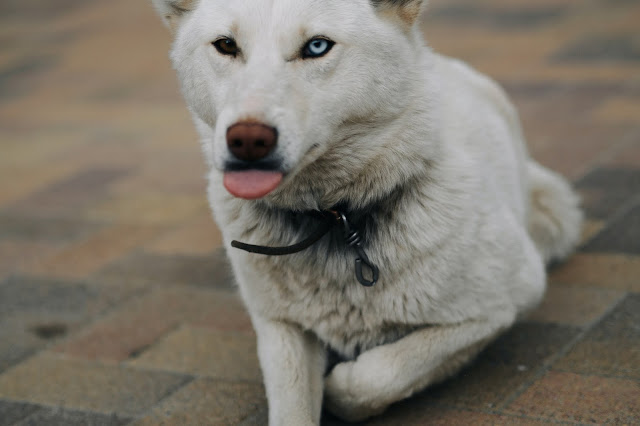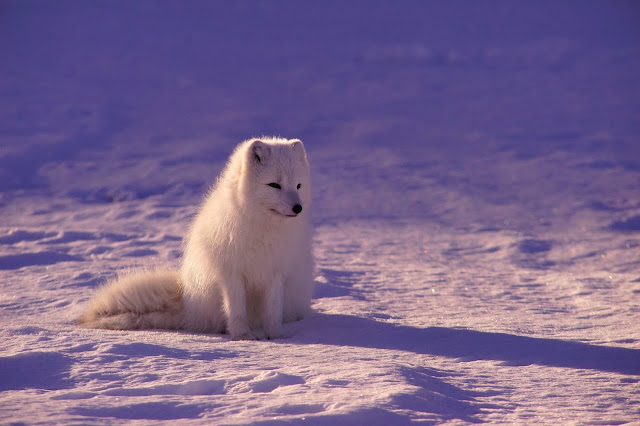The White Husky is truly one of the most beautiful dog breeds.
The white husky can be the most loyal, hardworking and loyal canine companion.
If you're thinking of adding a solid white husky to your family, you've come to the right place.
Many aspiring husky owners also have questions about how to find a white husky with blue eyes.
We will answer your questions about this here.
Learn everything you need to know about the White Husky breed in this in-depth breed guide.
We cover health and learning; leaving and molting; personality and temperament.
And even how to choose or adopt your new white husky puppy.
The White Husky Breed
White Husky is one of the common names that describes the Siberian husky breed of dog.
However, not all Siberian huskies have a pure white coat.
Some white huskies have yellow or beige coats that can be seen under proper lighting.
These dogs are called "Isabella Husky".
A white husky can have brown eyes, blue eyes, or multi-colored (two different colors) eyes.
Where did All White Husky come from?
The white husky is native to Siberia in northern Asia.
The first evidence of the existence of the husky breed dates back over 3000 years ago.
Huskies were originally bred by the Chukchi tribes in Asia to aid transportation and hunting.
The rest of the world did not know about husky dogs until the early 20th century.
When the toboggan team walked in and won the 408-mile All Alaska Sweepstakes Race in 1910.
Since the popularity of the Husky has grown, this breed of dog has spread throughout the world.
What Was the White Husky Bred to Do?

Huskies were bred to work as a sled dog with canine teammates and a human driver who was called a drover.
These dogs still participate in sled races.
One of the most famous sled dogs was a husky named Balto, who helped his team complete the 5-1 / 2-day 658 miles.
Deliver medicines to an isolated village in Alaska.
A film of the same name was shot based on Balto's story.
What Does a Purebred White Husky Look Like?
The purebred white husky is one of the most beautiful dogs on the planet.
These dogs have alert, erect, triangular ears and sharp almond-shaped eyes.
And strong, slender and proportional bodies, and fluffy, like a fox, tails.
The white husky can look deceivingly light, especially since this working dog has natural grace and poise.
But make no mistake; this dog is very strong and powerful.
White Husky Dog Grooming and Shedding
The very first huskies were bred in one of the harshest and coldest climates on Earth: Siberia.
These dogs have evolved to have a thick, two-layer insulating coat.
The top layer is water-repellent, while the bottom is thick and warm.
Huskies molt all year round.
Twice a year they will do something very memorable called "coat blowing."
As the name suggests, the white husky goes through a huge moulting cycle as the seasons change.
You should always groom and brush your husky to remove loose hairs that are stuck in the undercoat.
Debris and dirt will also need to be removed to avoid abrasions.
During seasonal haircuts, brush your dog daily to keep hair loss under control.
Luckily, you don't need to professionally groom or groom your dog, even if you want to show off your white husky.
The breed standard dictates the natural appearance.
White Husky Size, Height and Weight
The Siberian Husky is bred in two sizes: standard and miniature.
The Standard White Husky is considered a medium-sized dog that weighs 35 to 60 pounds.
Adult males will weigh about 10 pounds more than bitches.
Adult white huskies are usually 20 to 23.5 inches tall. These dogs are lean, muscular and strong.
A miniature husky will weigh 18 to 25 pounds and be 12 to 16 inches tall.
White Husky Personality and Temperament
The Husky breed evolved from a long line of working dogs that rode sledges as part of a pack.
This has created a very special breed of dog that is incredibly sociable and thrives around other dogs and people.
Siberian huskies sometimes have a reputation for being aggressive or temperamental.
Often the real reason is that the dog is left alone and not getting enough exercise.
A bored husky can quickly become destructive.
The white husky does not feel well if left alone for several hours every day.
This is not a lapdog or a domestic dog.
This dog requires an active lifestyle with a lot of stress and companionship every day.
White Husky Exercise Needs
The Siberian Husky is a service dog in heart and soul.
This dog breed has been carefully bred and developed for long distance running in very difficult conditions and weather.
This means your white husky will need to train a lot.
Running is likely to be your puppy's favorite exercise.
However, never let your husky get off the leash.
White Husky Training and Socialization
Sometimes white huskies are considered not very smart because they are difficult to train.
However, the Siberian Husky is incredibly smart.
Learning problems arise when you don't understand the unique history of your dog's breed and how it affects the husky's character.
Siberian huskies are very sociable and love the company of their people and other dogs.
However, their work usually involved long hours and whole days of running.
They don't hear traditional commands like "sit" and "stand" as often.
Thus, this breed has evolved to require more incentives to obey commands.
Training may take longer and require more reinforcement.
Siberian huskies are also bred to help their people on the hunt.
The husky has a very strong prey instinct that you cannot teach your dog.
If you have other vulnerable pets in your family, consider whether the husky is suitable.
Is a White Husky a Good Family Dog?
The Siberian Husky is not generally considered a good first-time dog breed.
These dogs may have special training and socialization needs and take a long time to exercise and groom.
However, the Husky breed has a strong desire to bond with its family.
Their social nature also makes them terrible guard dogs.
Full White Husky Health Issues

Like most purebred dogs, the white husky can inherit certain genetic health problems.
Hip and eye problems are some of the most serious health problems known to occur in white huskies.
Hip dysplasia, a disorder of the normal development of the hip joint, is the most serious hip problem affecting the husky.
The most serious vision problems that can affect white huskies include genetic cataracts, progressive retinal atrophy and corneal degeneration.
White Husky Health Testing
The Canine Health Information Center (CHIC) maintains an updated list of recommended genetic health tests.
Not all hereditary health problems can be found at birth.
Make sure you work with a breeder who tests and pre-vets parent dogs (breeding stock).
Husky tests currently recommended by CHIC include hip dysplasia and a thorough eye exam.
The breeder you choose must provide evidence that both parent dogs have been tested and cleared for these problems.
If you decide to get a white husky, ask your veterinarian for a physical examination before making your final decision.
Choosing a White Husky Puppy
Once you find a breeder who has a litter, including all white husky puppies, select your puppy.
Try to make an appointment with both parent dogs before committing to a puppy.
This will give you an idea of the adult size, appearance, and temperament of your new puppy.
Always choose a white husky puppy with clear eyes, alert and healthy.
Price of a Pure White Husky with Blue Eyes
The price you pay for a pure white husky with blue eyes can vary depending on a number of factors:
Pedigree
Awards of past exhibitions
Floor
"Pet" versus "show" quality
Breeder expenses
Supply and demand
White huskies are traditionally cheaper than marked huskies.
Blue-eyed huskies are traditionally more expensive than puppies with different eye colors.
These factors can also affect the final price of your puppy.
At the time of this publication, the cost of white huskies with blue eyes from reputable breeders ranges from $ 400 to $ 800.
Siberian huskies are bred in standard and miniature sizes.
If you are interested in a mini white husky, expect to pay between $ 750 and $ 1200.
Finding a White Husky to Adopt
If you like a white husky puppy, finding a white husky to adopt can be more difficult than finding a breeder.
However, there are advantages to finding an adult white husky to adopt rather than a puppy.
One such advantage is cost.
You can pay anywhere from $ 50 to $ 200 for a repeat return of an adult white husky.
This is compared to a few hundred or even a thousand dollars per puppy.
Your adult white husky with blue eyes will already be house-trained and may receive additional training under his or her belt.
Many rescue organizations offer additional support to new foster parents to strengthen their bond.
And they increase the chances of a successful match.
Services can include sterilization / sterilization, free or low-cost training courses, consumables, and more.
But the best part is that the white husky will have a long-awaited home forever.
Is a White Husky the Right Pet Dog for Me?
Surely seeing an all-white husky with blue eyes is a stop.
There is no denying the "attractiveness factor" of a pure white husky puppy.
But this guide confirms that the white husky may not be suitable for every family.
Will there be a pure white husky in your future? We'd love to hear your comments.
Resources and Further Reading:
- Brent, M., 2008, “A Brief History of the Siberian Husky,” Siberian Husky Welfare Association/Dreamcatcher
- “History of the Breed,” Tails of the Tundra Siberian Husky Rescue
- “How Much Does a Miniature Siberian Husky Cost?” 2014, MiniHuskies
- “Siberian Husky,” 2015, Husky House K-9 Rescue
- O’Brien, J., Stryeski, K., and Blanker, S., 2015, “Your Siberian: Its Hips and Its Eyes,” Siberian Husky Club of America, Inc.
- “Official Standard of the Siberian Husky,” 1990, American Kennel Club





